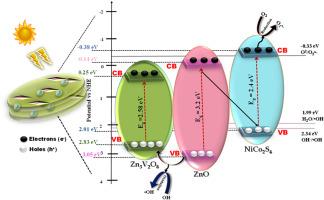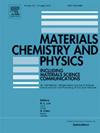用于增强利福平光催化降解的三明治状 Zn3V2O8/ZnO/NiCo2S4 纳米异质结的界面耦合
IF 4.3
3区 材料科学
Q2 MATERIALS SCIENCE, MULTIDISCIPLINARY
引用次数: 0
摘要
抗生素的过度使用以及这些药物释放到水系统中已成为一个严重问题,对水生物种的生命环境构成威胁。与各种污染物不同,抗生素是专门为人体系统(人类健康)的耐久性和有效性而设计的。虽然这种设计确保了抗生素的性能,但同时也延长了抗生素的寿命,使其在自然环境中不易降解。利用三元异质结纳米催化剂(NCs)的高级氧化工艺(AOP)可以解决这些难题。在本研究中,NCs 是通过煅烧辅助反向微乳化法和水热法合成的。利用各种分析技术对合成的 NC 进行了表征。Zn3V2O8/ZnO/NiCo2S4 (ZZN) NCs 中电荷分离和迁移的增强使得利福平(RIF)在 80 分钟内的降解率达到 97.3%。与原始 Zn3V2O8、ZnO、NiCo2S4 和二元 ZnO/NiCo2S4 相比,ZZN NCs 在可见光照射下表现出更优越的催化性能。光催化性能的增强主要归因于级联驱动的电荷转移机制促进了 Zn3V2O8、氧化锌和 NiCo2S4 之间的协同效应。参与光催化降解活性的主要活性氧是超氧化物(O2--)和氢氧自由基(-OH),这一点已通过 ESR 和淬灭实验得到证实。从实际应用的角度来看,ZZN NCs 三元异质结构在循环使用六次后表现出了优异的稳定性和耐久性。这项研究为今后研究与异质结构数控材料相关的光催化机理提供了重要参考,凸显了它们在采用环保方法消除污染物方面的潜力,并为不久的将来的制造创新铺平了道路。本文章由计算机程序翻译,如有差异,请以英文原文为准。

Interfacial coupling of sandwich like Zn3V2O8/ZnO/NiCo2S4 nano-heterojunction for the enhanced photocatalytic degradation of rifampicin
The overuse of antibiotics and the release of these pharmaceuticals into the water system has emerged as a serious issue posing a life-threatening environment to aquatic species. In contrast to various contaminants, antibiotics are specifically engineered for durability and efficacy in the system of the human body (human health). Although this design ensures their performance, it also results in their extended longevity and resilience against degradation in natural contexts. These challenges can be addressed by an advanced oxidation process (AOP) utilizing ternary heterojunction nano catalysts (NCs). In this study, the NCs were synthesized through a combination of calcinated-assisted reverse microemulsion and hydrothermal methods. The synthesized NCs were characterized by using various analytical techniques. The enhanced charge separation and migration in Zn3V2O8/ZnO/NiCo2S4 (ZZN) NCs results in 97.3 % degradation of rifampicin (RIF) within 80 min. ZZN NCs exhibit superior catalytic performance under visible light irradiation compared to its pristine Zn3V2O8, ZnO, NiCo2S4, and binary ZnO/NiCo2S4. The enhanced photocatalytic performance can be primarily attributed to the synergetic effects among Zn3V2O8, ZnO, and NiCo2S4 facilitated by the cascade-driven charge transfer mechanism. The prominent reactive oxygen species that participated in photocatalytic degradation activity were found to be superoxide (O2•-) and hydroxide radicals (•OH) which were confirmed through ESR and quenching experiments. From the practical application perspective, ZZN NCs ternary heterostructure demonstrated excellent stability and durability after being recycled six times. This study serve as a vital reference for future investigation into the photocatalytic mechanism related to heterostructure NCs, highlighting their potential for eco-friendly methods to eliminate pollutants and paves a way for manufacturing innovation in near future.
求助全文
通过发布文献求助,成功后即可免费获取论文全文。
去求助
来源期刊

Materials Chemistry and Physics
工程技术-材料科学:综合
CiteScore
8.70
自引率
4.30%
发文量
1515
审稿时长
69 days
期刊介绍:
Materials Chemistry and Physics is devoted to short communications, full-length research papers and feature articles on interrelationships among structure, properties, processing and performance of materials. The Editors welcome manuscripts on thin films, surface and interface science, materials degradation and reliability, metallurgy, semiconductors and optoelectronic materials, fine ceramics, magnetics, superconductors, specialty polymers, nano-materials and composite materials.
 求助内容:
求助内容: 应助结果提醒方式:
应助结果提醒方式:


